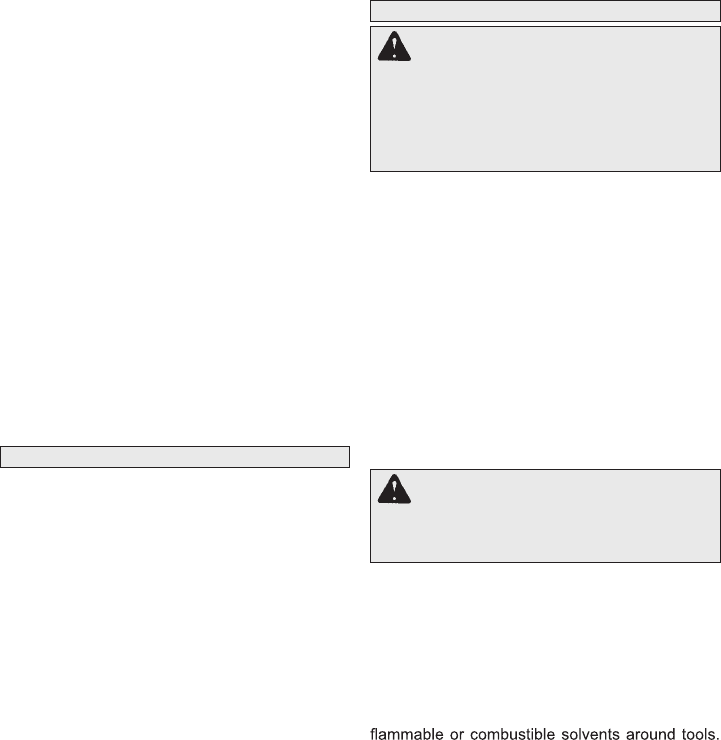
6
APPLICATIONS
Starting,StoppingandControllingSpeed
1. To start the tool, grasp the handle rmly and pull
the trigger.
NOTE: An LED is turned on when the trigger is
pulled.
2. To vary the speed, increase or decrease the
pressure on the trigger. The further the trigger
is pulled, the greater the speed.
3. To stop the tool, release the trigger. Make sure
the tool comes to a complete stop before laying
the tool down.
Operating
Position the tool, grasp the handle rmly and pull
the trigger. Always hold the tool securely to maintain
control. This tool has been designed to achieve top
performance with only moderate pressure. Let the
tool do the work.
If the speed begins to drop off when drilling large
or deep holes, pull the bit partially out of the hole
while the tool is running to help clear dust. Do not
use water to settle the dust since it will clog the bit
utes and tend to make the bit bind in the hole. If
the bit should bind, stop the tool, free the bit and
begin again.
MaintainingTool
Keep your tool, battery pack and charger in good
repair by adopting a regular maintenance program.
After six months to one year, depending on use,
return the tool, battery pack and charger to A
MILWAUKEE service facility for:
• Lubrication
• Mechanical inspection and cleaning (gears,
spindles, bearings, housing, etc.)
• Electrical inspection (battery pack, charger,
motor)
• Testing to assure proper mechanical and electrical
operation
If the tool does not start or operate at full power
with a fully charged battery pack, clean the contacts
on the battery pack. If the tool still does not work
properly, return the tool, charger and battery pack,
to a MILWAUKEE service facility for repairs.
MAINTENANCE
WARNING Toreducetheriskofper-
sonalinjuryanddamage,neverimmerseyour
tool,batterypackorchargerinliquidorallow
aliquidtoowinsidethem.
WARNING Toreducetheriskofinjury,
alwaysunplugthechargerandremovethe
batterypackfromthechargerortoolbefore
performinganymaintenance.Neverdisas-
semblethetool,batterypackorcharger.
ContactaMILWAUKEEservicefacilityfor
ALLrepairs.
SelectingBits
When selecting a bit, use the right type for your job.
For best performance, always use sharp bits.
Drilling
1. Before drilling, be sure the workpiece is clamped
securely. Use backing material to prevent dam-
age to the workpiece during breakthrough.
2. When starting a hole, place the drill bit on the
work surface and apply rm pressure. Begin
drilling at a slow speed, gradually increasing the
speed as you drill.
3. Always apply pressure in line with the bit. Use
enough pressure to keep the drill biting, but do
not push hard enough to stall the motor.
4. Reduce pressure and ease the bit through the
last part of the hole. While the tool is still running,
pull the bit out of the hole to prevent jamming.
DrillinginWood,CompositionMaterialsand
Plastic
(UsechuckadapterkitCat.No.48-66-1370)
When drilling in wood, composition materials and
plastic, start the drill slowly, gradually increasing
speed as you drill. When drilling into wood, use
wood augers or twist drill bits. Always use sharp
bits. When using twist drill bits, pull the bit out of the
hole frequently to clear chips from the bit utes. To
reduce the chance of splintering, back work with a
piece of scrap wood. Use low speeds for plastics
with a low melting point.
Repairs
For repairs, return the tool, battery pack and
charger to the nearest service centre, please visit
customer service centre (Australia Toll Free
Telephone Number 1300 361 505) (New Zealand
Toll Free Telephone Number 0800 279 624).
www.milwaukeetools.com.au /
www.milwaukeetools.co.nz or contact our
Cleaning
Clean dust and debr
is from charger and tool vents.
Keep tool handles clean, dry and free of oil or
grease. Use only mild soap and a damp cloth to
clean the tool, battery pack and charger since certain
cleaning agents and solvents are harmful to plastics
and other insulated parts. Some of these include
gasoline, turpentine, lacquer thinner, paint thinner,
chlorinated cleaning solvents, ammonia and house-
hold detergents containing ammonia. Never use










